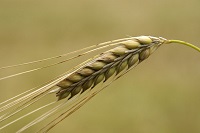09/02/2013
POPSEQ for Plant Genome Assembly: New Approach Allows Researchers to Work on Many Species Regardless of Sequence Resources

Cultivated barley is the fourth most abundant crop in the world and a model for plant genetics research.
Image courtesy of freefotouk, Flickr CC BY 2.0
Summary
One of the challenges in assembling plant genome “contigs,” fragments of the entire genome that are identified by the assembly algorithms, is that they are not easily linked together or even placed in their proper order. In an effort to mitigate this problem, researchers with the U.S. Department of Energy’s (DOE) Joint Genome Institute (JGI) teamed with other researchers to develop another approach for assembling contigs.
In a study published in The Plant Journal, the team reports on the results of testing the approach they call POPSEQ with the barley genome. The plant was selected for DOE JGI’s 2011 Community Sequencing Program portfolio in part for its potential as a bioenergy feedstock crop. Grown on four million acres in the United States, the crop could be used to produce cellulosic ethanol from the straw. More than 80 percent of the 5.1 billion-base genome is composed of repeats, adding to its complexity.
Using POPSEQ, researchers assembled the barley genome while testing a number of variables. For example, they used datasets obtained from different mapping populations, or, in another case, assembled the genome based solely on short reads. The team reported that the results from these tests were comparable with the assembly previously produced by the International Barley Sequencing Consortium. “By comparison,” they wrote, “POPSEQ is inexpensive, rapid, and conceptually simple, the most time-consuming step being the construction of a mapping population…The method is independent of the need for any prior sequence resources,” and this proof of principle demonstrates that POPSEQ can be effectively applied to many species.
References
Mascher, M., et al. 2013. “Anchoring and Ordering NGS Contig Assemblies by Population Sequencing (POPSEQ),” The Plant Journal, DOI: 10.1111/tpj.12319.